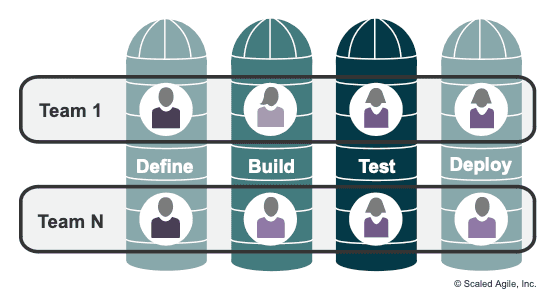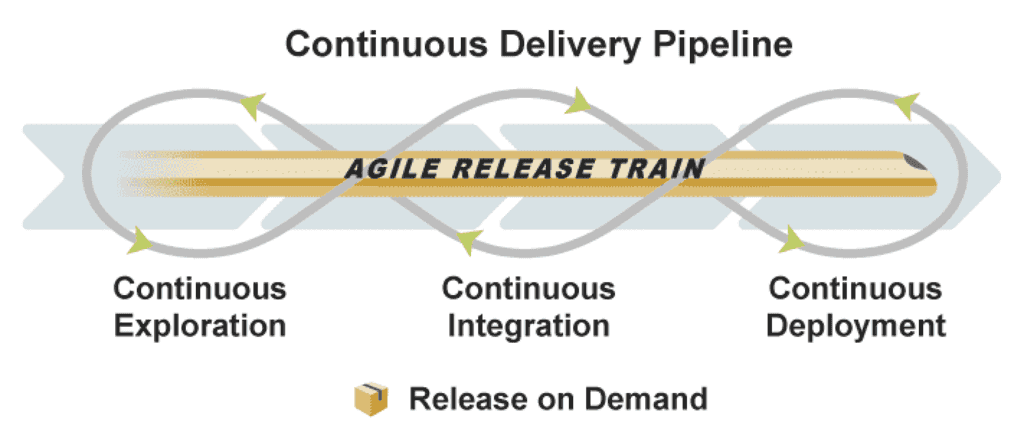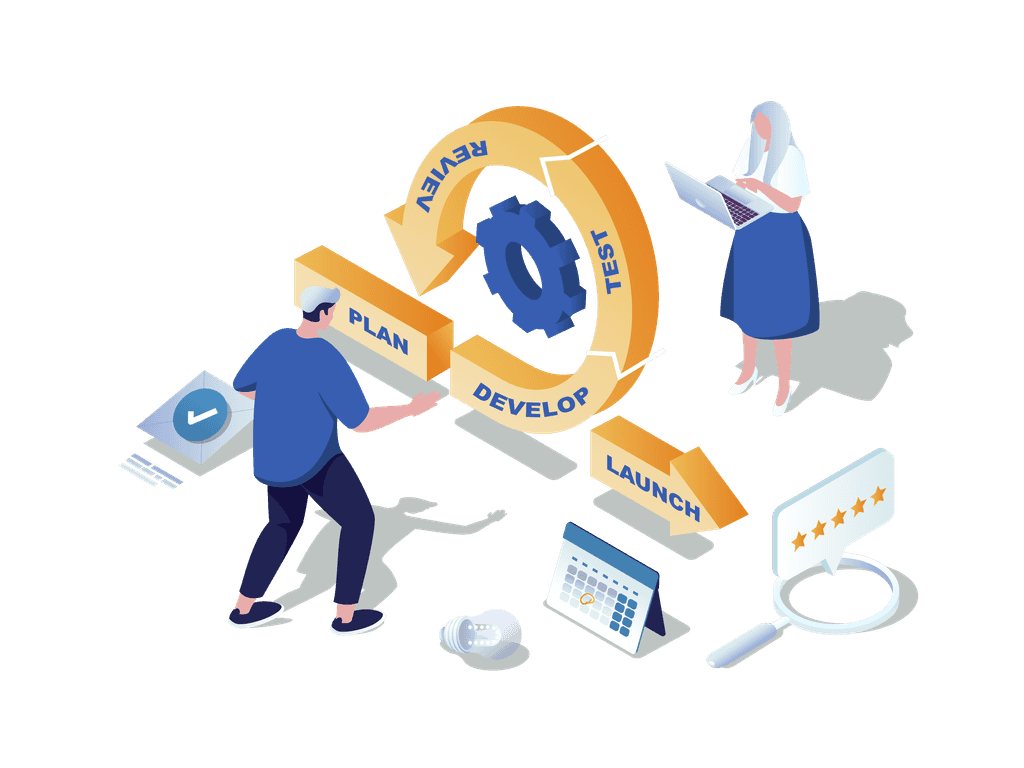Rules to Better Scaled Agile Framework (SAFe) - 10 Rules
Video: SAFe Explained (5min)
While many of us appreciate the benefits of Scrum in project management, the challenge amplifies when coordinating multiple Scrum teams towards a singular vision. In such scenarios, maintaining alignment and ensuring consistent value delivery at scale can become overwhelming. This is precisely where the Scaled Agile Framework (SAFe) steps in.
What is SAFe?
SAFe, or the Scaled Agile Framework, is a comprehensive agile software development framework crafted by Scaled Agile. While traditional agile methodologies like Scrum are tailored for individual teams, SAFe is designed specifically for larger enterprises.
It provides a structured approach to scaling agile and lean practices across multiple teams or departments. By doing so, SAFe ensures alignment, collaboration, and delivery across vast organizational landscapes, driving teams towards unified strategic objectives.
Benefits of using SAFe
Use SAFe to align your Scrum teams and work towards common objectives.
Alignment
SAFe ensures that multiple agile teams are seamlessly aligned, collaboratively working towards shared organizational objectives.
By fostering a clear understanding of strategic goals and value streams across teams, SAFe eliminates silos and promotes a unified approach to problem-solving and product delivery. This centralized vision not only streamlines processes but also ensures that all teams are consistently moving in the right direction, maximizing the overall value delivered to the end-users and stakeholders.
Coordination
SAFe adeptly streamlines roles and responsibilities, facilitating enhanced coordination among diverse teams.
By establishing clear interfaces and touchpoints, SAFe ensures that teams can collaboratively address dependencies, manage risks, and seamlessly integrate their efforts. This coordinated approach not only reduces potential bottlenecks and conflicts but also fosters an environment where teams can synergize their strengths and work harmoniously towards collective outcomes.
Quality
SAFe places a significant emphasis on continuous delivery, ensuring that quality remains at the forefront of all endeavors.
By integrating practices such as built-in quality checks, regular feedback loops, and iterative improvements, SAFe ensures that products and solutions not only meet but often exceed expectations. This commitment to quality extends beyond the codebase; it encompasses the overall user experience, functionality, and performance. As a result, organizations leveraging SAFe can be confident in delivering solutions that are robust, reliable, and resonate with the needs of the end-users.
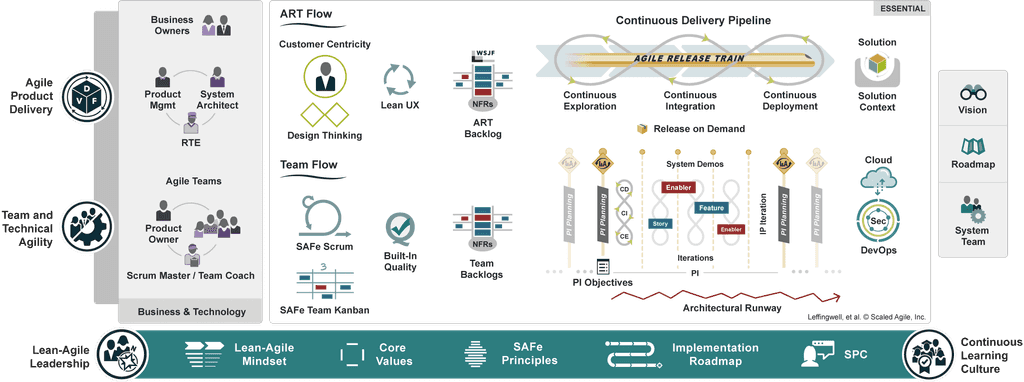
Figure: Good example - Using SAFe to align multiple Scrum teams ensures everyone is working towards the same goals, improving efficiency and output Why should you use SAFe?
Implement SAFe practices to scale your agile teams.
Better scalability
Scrum is undoubtedly effective for single teams, delivering agility and adaptability in those settings. However, when the organizational landscape involves multiple teams or even entire departments, the complexities grow exponentially. SAFe addresses this challenge head-on by offering a robust framework that allows for scalability.
It provides the structure and guidelines necessary to scale up agile practices across the organization without sacrificing the core principles of agility. This means organizations can handle larger initiatives, coordinate across diverse teams, and ensure that they're all aligned, efficient, and responsive, all while maintaining the agile spirit.
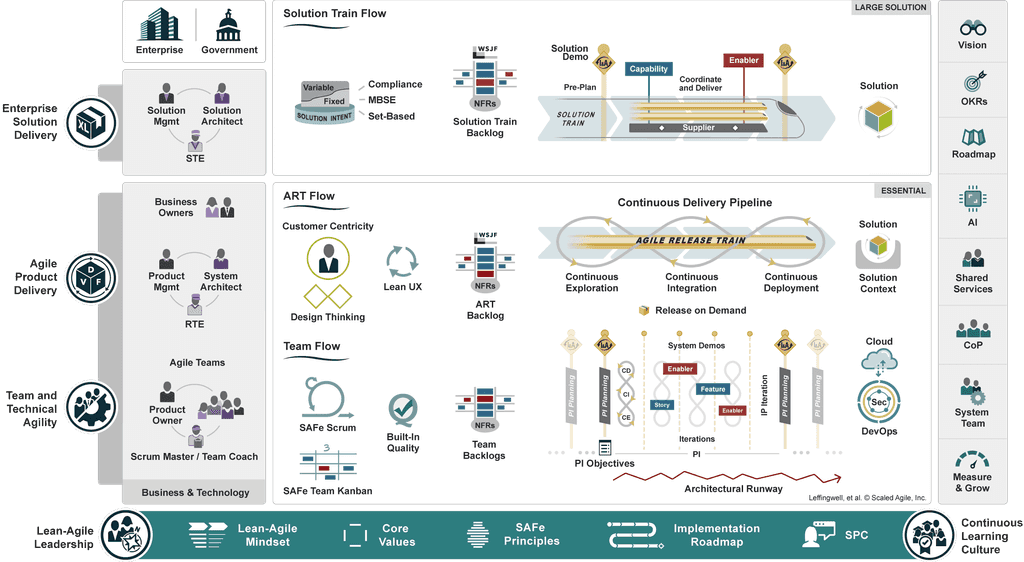
Figure: Good example - SAFe allows for better scalability while maintaining agile principles, making it ideal for large projects Improved governance
Adopt SAFe for a balanced approach to governance and agility.
SAFe introduces a refined approach to governance, skillfully balancing the need for structure with the agility that's paramount in modern development. By providing clear roles, responsibilities, and decision-making protocols, SAFe ensures that compliance and quality standards are consistently upheld.
But what truly sets it apart is its ability to achieve this without suffocating the agile spirit. Through its iterative processes and feedback mechanisms, SAFe empowers teams to adapt and innovate, all while operating within a defined governance framework. This results in a system where governance becomes an enabler, rather than a barrier, to rapid and effective product development.
Conclusion
In today's complex development landscape, managing multiple Scrum teams can pose significant alignment and coordination challenges. Adopting SAFe stands as a powerful remedy to these issues. More than just aligning teams, SAFe provides a comprehensive framework tailored for scaling agile practices effectively, ensuring consistent quality, and facilitating improved governance.
As you navigate the intricacies of large-scale projects, integrating the SAFe methodology can indeed be a transformative decision for your organization.
Imagine managing a bunch of projects, each with its own goals and deadlines. It's easy to get caught up in the details and miss the bigger picture. Sometimes, even though every project seems super important, they might not all line up with what the business really needs. That's when you realize: it's all about focusing on value streams, not just individual projects.
What Are Value Streams?
Think of value streams like a roadmap. They're the steps an organization takes to whip up solutions that keep the good stuff – value – constantly flowing to customers. Instead of just diving into projects headfirst, focusing on value streams ensures everything we do is all about delivering the best bang for the buck for both customers and the business.
Benefits of Prioritising Value Streams
Alignment with Business Goals
When you focus on value streams, you're basically making sure everything you do lines up with the big goals of the business. Instead of getting lost in the weeds of random tasks, you're always on track with what really matters for the company.
Efficiency
When you zero in on value streams, it's like decluttering your workspace. You toss out the unnecessary stuff and make everything run smoother. No more wasted effort—just a streamlined flow of work that makes sense.
Customer-Centric
It's like giving your customers exactly what they've been craving for. With this approach, you're not just checking boxes; you're delivering stuff that really makes a difference to the people who matter most – the customers.
Align your work with value streams to ensure maximum business and customer value.
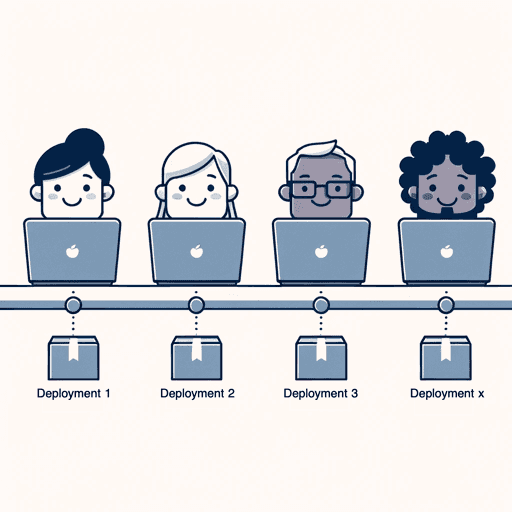
Figure: Good Example - Prioritizing value streams ensures that all activities are aligned with delivering customer and business value. Why Should You Prioritise Value Streams?
Greater Business Agility
Think of it this way: choosing value streams over just projects is like having a nimble dance step. You can quickly pivot and change direction, making your business groove smoothly with whatever tune the market's playing.
Adopt a value stream focus for greater agility.
Improved ROI
By centering your efforts on true value, you're essentially optimizing where resources are directed. This focus ensures that every ounce of effort and investment aligns with the highest value outcomes.
The result? A more robust return on investment (ROI), as you're systematically aligning work with what delivers the greatest value.
Focus on value streams for better ROI.
Conclusion
Choosing to prioritise value streams above isolated projects isn't just a change in process—it's a strategic move. This approach not only aligns your efforts with overarching business objectives but also bolsters efficiency and guarantees genuine value delivery to customers.
Embracing this perspective could be the game-changer your business needs for improved outcomes.
In any bustling organization, it's common to see multiple teams working at their own pace, each with its distinct flavor of 'agility'. But what happens when some of those flavors are a tad outdated? The result: a mix of inefficiencies, delays, and missed beats.
It's like trying to play in harmony with instruments out of tune. The remedy? Striking the right chord with a consistent Lean-Agile mindset across the board.
What is a Lean-Agile Mindset?
A Lean-Agile mindset melds together the best of two worlds: Lean's dedication to efficiency and waste reduction, and Agile's commitment to adaptability and customer value. It's not just about following a set of practices; it's about adopting a belief system.
This mindset cultivates a culture where teams are constantly evolving, honing their processes, and keeping a laser focus on delivering real value at every turn.
Benefits of a Lean-Agile Mindset
Efficiency
Embracing Lean principles within the Agile framework supercharges your team's efficiency. By meticulously cutting out the fluff and zeroing in on activities that genuinely add value, you ensure that every move made, every task undertaken, directly contributes to the end goal.
It's like fine-tuning an engine to run smoother, faster, and more reliably.
Flexibility
In today's dynamic business landscape, adaptability is key. Agile methodologies serve as the backbone for this adaptability, enabling teams to swiftly adjust to shifts in requirements or unforeseen challenges. It's akin to having a navigation system that's always ready to suggest the next best route when the initial path is obstructed.
Collaboration
In a Lean-Agile environment, silos don't stand a chance. The mindset actively promotes a culture where collaboration isn't just encouraged—it's integral. Team members come together, pooling their expertise and sharing the responsibility of crafting top-notch solutions.
This collective approach ensures that projects benefit from diverse perspectives, leading to more robust and well-rounded outcomes.
Cultivate a Lean-Agile mindset to improve efficiency, flexibility, and collaboration.
Why Should You Establish a Lean-Agile Mindset?
Consistency Across Teams
Ever tried herding cats? Getting diverse teams to move in unison can feel just as challenging. However, with a shared Lean-Agile mindset, this task becomes infinitely more manageable. When all teams operate from the same playbook, aligning them toward unified objectives and milestones becomes a smoother, more streamlined endeavor.
Standardize the Lean-Agile mindset for consistent performance across teams.
Improved Value Delivery
In a world driven by value, a Lean-Agile mindset isn't just a choice—it's a mandate. By perpetually centering on what brings the most value to the table, both for customers and the organization, outcomes aren't just improved; they're optimized.
It's a commitment to a continuous cycle of delivering the best, every single time.
Adopt a Lean-Agile mindset for better value delivery.
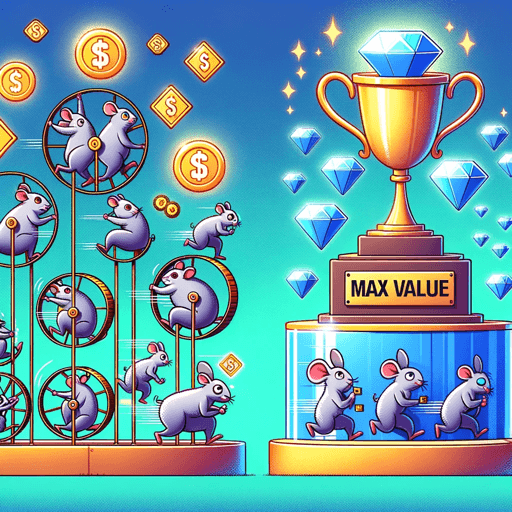
Figure: Bad Example - Teams without a Lean-Agile mindset may focus on tasks that don't deliver maximum value. Conclusion
Establishing a Lean-Agile mindset across all teams is not just a philosophical change; it's a practical approach to improving efficiency, adaptability, and value delivery. It ensures that all teams are aligned and moving in the same direction, making it easier to achieve business objectives.
As organizations continue to evolve in a rapidly changing market, embracing this mindset will be crucial for sustained success and growth.
When development and operations teams operate in their separate bubbles, it's a recipe for deployment delays and mounting bottlenecks. Imagine developers crafting features at lightning speed, but the operations team is playing catch-up, trying to deploy them. This divide doesn't just create hiccups; it hinders the prompt delivery of new features and essential fixes.
It's akin to a relay race where the baton handoff keeps tripping the runners. The solution? Merging these two worlds with DevOps practices focused on continuous delivery, ensuring a smooth and uninterrupted journey from development to deployment.
What is DevOps?
DevOps is more than just a buzzword; it's a transformative approach to the world of software delivery. At its core, DevOps blends the best of software development (Dev) and IT operations (Ops).
But why merge these two? The answer lies in its objectives: to compress the system development life cycle, ensure continuous delivery with high software quality, and foster a culture of collaboration. In essence, DevOps aims to streamline processes, eliminate silos, and deliver value faster and more efficiently.
Benefits of Implementing DevOps
Speed
In today's digital era, being first often means being the best. DevOps isn't just about speed for speed's sake; it's about staying ahead of the curve and outpacing competitors. By streamlining development and operations processes, DevOps acts as a catalyst, accelerating the journey from idea to deployment.
This not only trims down your time to market but also positions your product or service at the forefront, ready to capture opportunities quicker than ever.
Reliability
Surprises in software delivery can be costly and disruptive. DevOps minimizes these unexpected issues. Automated testing identifies potential flaws early in the process, ensuring they're addressed well before deployment. Coupled with continuous monitoring, this vigilant oversight guarantees system robustness and resilience once live.
The outcome?
Deliverables that are not only swift but also steadfastly reliable, bolstering user satisfaction and trust.
Collaboration
The beauty of DevOps lies not just in merging processes, but also in bridging people. By breaking down silos and fostering an environment of open communication, DevOps brings development and operations teams closer than ever before.
This enhanced collaboration means shared responsibilities, combined insights, and a unified approach to problem-solving. The outcome is a synergy where teams don't just work alongside each other, but truly together, leading to more innovative solutions and swifter resolutions.
Implement DevOps practices to streamline development and operations.
Why Should You Implement DevOps?
Seamless Integration
Traditionally, the handoff between development and operations could be a fraught moment, laden with potential hiccups and delays. However, with DevOps, these two critical phases intertwine seamlessly. This seamless integration ensures a smooth transition, eliminating the usual bottlenecks that can stall deployment.
The outcome is a significantly reduced time from code completion to going live, ensuring that innovations reach the market swiftly and reliably.
Adopt DevOps for a seamless integration between development and operations.
Risk Mitigation
In the realm of software delivery, risks can translate to downtime, user dissatisfaction, or even financial loss. DevOps is uniquely equipped to tackle these challenges head-on. By embedding continuous testing within the development cycle, potential pitfalls are detected and addressed long before they escalate.
Additionally, with continuous monitoring in place, any post-deployment anomalies are promptly identified. Together, these practices drastically reduce the risks associated with deployments, ensuring a smoother and more reliable user experience.
Utilize DevOps for continuous testing and risk mitigation.
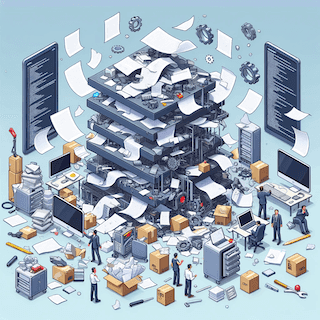
Figure: Bad Example - Lack of DevOps practices can lead to risky deployments and frequent rollbacks. Conclusion
Embracing DevOps practices for continuous delivery goes beyond mere technical adjustments—it's a transformative cultural shift. By bridging the divide between development and operations teams, it fosters an environment of collaboration and shared purpose.
The result?
Deployments that are not only swifter but also more reliable and secure. In this landscape, the entire software development life cycle is supercharged, paving the way for enhanced efficiency and, ultimately, a more agile and responsive business.
Picture this: You've got a fleet of agile teams, each buzzing with activity. Yet, despite their hard work, aligning their efforts feels like trying to synchronize an orchestra without a conductor. Deadlines slip through the cracks, and the big picture gets fuzzy.
This is where a Release Train Engineer (RTE) steps in. Think of the RTE as your agile conductor, harmonizing these teams to ensure they stay in sync, hit their deadlines, and align their outputs with overarching business goals.
What is a Release Train Engineer (RTE)?
A Release Train Engineer (RTE) plays a pivotal role in the Agile Release Train (ART), acting as both a servant leader and a coach. In this capacity, the RTE isn't just overseeing; they're deeply involved in facilitating ART events and processes, ensuring everything runs like clockwork.
Their primary mission?To assist and guide the teams within the ART, helping them navigate challenges and effectively deliver value. The RTE's role is crucial in aligning the teams' efforts with the larger organizational objectives and ensuring a smooth, consistent flow of work.
Benefits of Utilizing an RTE
Synchronization
An RTE is the linchpin for maintaining synchronization across all teams on the Agile Release Train. They ensure not just routine alignment but a deep-seated harmony with the train's mission and objectives. By doing so, the RTE helps prevent the derailment of projects due to misalignment or miscommunication.
It's like having an expert conductor who ensures that every part of the orchestra plays in unison, creating a symphony rather than a cacophony. This synchronization is vital for timely and cohesive deliverables, directly impacting the success of the entire train.
Facilitation
The RTE plays a crucial role in steering the program-level processes and execution. This isn't just about keeping meetings on track or ticking boxes on a checklist. It's about creating an environment where collaboration is seamless, decision-making is efficient, and execution is smooth.
From planning sessions to retrospectives, the RTE ensures that each step in the Agile Release Train is conducted with precision and purpose. Their expertise in facilitation helps bridge gaps, iron out kinks, and keep the entire program moving forward cohesively and effectively.
Conflict Resolution
The RTE often steps into the role of a mediator, a crucial aspect when multiple teams are working together under tight deadlines and high stakes. In such an environment, conflicts, whether between teams or within them, are inevitable. The RTE's skill in navigating these disagreements is key. They work not just to find quick fixes, but to address underlying issues, fostering an atmosphere of understanding and collaboration.
This conflict resolution capability is vital in maintaining team morale, ensuring smooth collaboration, and keeping the Agile Release Train on track towards its objectives.
Utilize an RTE to keep your agile teams synchronized and focused on delivering value.
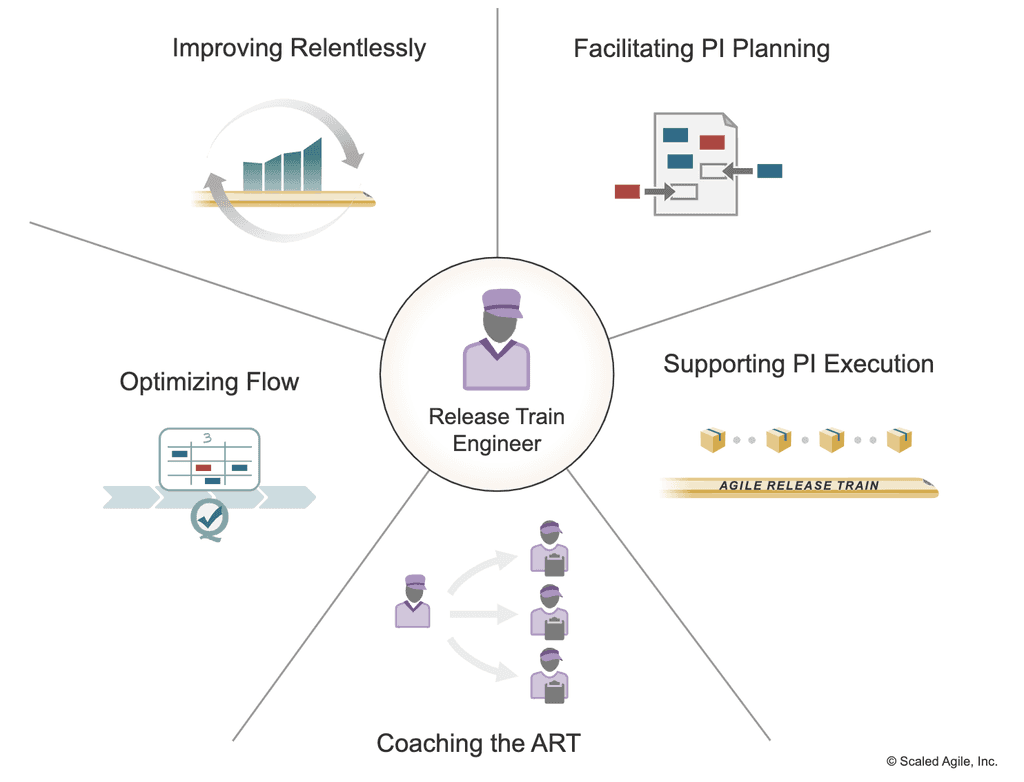
Figure: Good Example - An RTE helps in keeping all the agile teams in sync, ensuring smooth delivery of features. Why Should You Utilize an RTE?
Improved Coordination
Utilizing an RTE introduces a pivotal element in large-scale project management: a centralized coordination hub. When you have multiple teams, each with their unique dynamics and workflows, orchestrating their efforts can be a complex task. An RTE simplifies this by serving as the single point of contact and oversight.
This streamlined coordination not only makes managing the teams more straightforward but also ensures that everyone is moving in sync, following a unified strategy. The presence of an RTE thus leads to smoother operations, clearer communication, and a more cohesive approach to reaching project milestones.
Appoint an RTE for centralized coordination and management.
Enhanced Communication
An RTE is not just a facilitator but a vital communication nexus within the Agile Release Train. In complex projects with multiple stakeholders, messages can easily become muddled or lost in translation. The RTE actively works to prevent this. By maintaining open, clear channels of communication, they ensure that everyone, from team members to top management, is on the same page.
This enhanced communication is key to avoiding misunderstandings, ensuring transparency, and fostering a collaborative environment. Ultimately, it contributes to the overall health and success of the project, keeping everyone aligned and focused on common goals.
Rely on an RTE for effective communication between teams and stakeholders.
Bad Example - Lack of an RTE can lead to communication gaps, causing delays and misunderstandings.
Conclusion
Employing a Release Train Engineer (RTE) is more than a strategic decision; it's a critical component for success in any scaled agile framework.
An RTE does much more than just keep the wheels turning; they ensure that multiple agile teams work in harmony, like a well-oiled machine. From seamless communication and pinpoint coordination to adept conflict resolution, the RTE's role is multifaceted and indispensable. They stand as the cornerstone of any Agile Release Train, orchestrating efforts to drive efficiency, alignment, and, ultimately, success.
As you gear up for a new Program Increment (PI), your development teams are primed and ready. But there's a critical piece missing: active involvement from your business stakeholders.
Without their insights, there's a tangible risk of a disconnect, where the development efforts might not fully align with the actual business requirements. Actively involving these stakeholders in PI planning is key to ensuring that what's being built truly meets the business needs and objectives.
What is Program Increment (PI) Planning?
Program Increment (PI) planning is a cornerstone event within the Scaled Agile Framework (SAFe), bringing together all the players of an Agile Release Train (ART). This pivotal gathering is not just a routine meeting; it's a strategic forum. Here, team members collectively dissect and understand the priorities for the upcoming PI.
They delve into technical considerations, align on objectives, and collaboratively forge a roadmap. The goal? To ensure that everyone is marching in the same direction, equipped with a clear, cohesive plan for the journey ahead.
Benefits of Involving Business Stakeholders
Alignment
Involving business stakeholders in PI planning isn't just a procedural step; it's a strategic move. By bringing these key players into the conversation, you ensure that the development work isn't just technically sound, but also perfectly aligned with the broader business objectives.
This alignment is crucial—it means that every Sprint, every line of code, contributes directly to the overarching goals of the organization, ensuring that the efforts of the Agile Release Train (ART) are not just efficient but also effective and relevant.
Clarity
Bringing business stakeholders into the fold of PI planning does more than facilitate decision-making; it illuminates the path ahead. It provides crystal-clear clarity on what the business deems as priorities and articulates the specific requirements that need to be met. This clarity is invaluable. It ensures that every team member on the Agile Release Train (ART) understands not just the 'what' and the 'how' of their tasks, but more importantly, the 'why'.
Such understanding is crucial for aligning their day-to-day work with the strategic vision of the business, leading to more targeted and impactful outcomes.
Feedback Loop
Integrating business stakeholders into PI planning sets the stage for an essential component of agile methodology: a dynamic, immediate feedback loop. This connection between the development teams and the business stakeholders isn’t just about staying informed; it's about creating a responsive and adaptive environment.
It allows for real-time feedback, ensuring that any deviations from business goals can be swiftly identified and rectified. This ongoing exchange keeps the development aligned with business expectations, fostering a collaborative atmosphere where adjustments can be made quickly, enhancing both the product's relevance and its quality.
Involve business stakeholders in PI planning to align development work with business objectives.
Good Example - Involving business stakeholders in PI planning ensures that everyone is aligned and working toward the same goals.
Why Should You Involve Business Stakeholders?
Better Decision-Making
Involving business stakeholders in the planning process does more than just add more voices to the conversation; it enriches the decision-making process with critical business insights. These stakeholders bring a deep understanding of business context and priorities, ensuring that decisions aren't made in a vacuum.
Their input helps to ground the planning in real-world business needs and goals, leading to choices that are not just technically feasible but also strategically sound. This results in a planning process that is more attuned to the market realities and organizational objectives, paving the way for outcomes that resonate with both the business and its customers.
Include business stakeholders for informed decision-making.
Good Example - Business stakeholders can provide valuable insights that lead to better decisions during PI planning.
Risk Mitigation
Getting business stakeholders in on the ground floor of the planning process isn't just about ticking a box; it's a strategic move for risk mitigation. Their early involvement brings a wealth of knowledge about the market landscape, regulatory compliance, and various other business-critical factors.
This insight is invaluable for identifying potential risks early on, allowing the team to proactively address them before they escalate. By integrating this business acumen into the planning stages, the team can devise strategies that are not only innovative but also aligned with real-world constraints and requirements, thereby reducing the likelihood of costly, time-consuming issues down the line.
Engage business stakeholders for early risk identification and mitigation.
Bad Example - Excluding business stakeholders can result in overlooking important business risks and priorities.
Conclusion
Bringing business stakeholders into the heart of Program Increment (PI) planning is more than a procedural necessity; it's a strategic imperative. Their involvement ensures that the development work aligns seamlessly with business objectives, adding depth and context to decision-making. Beyond this, their insights are instrumental in identifying and mitigating risks early in the process.
This proactive approach to planning not only fosters a more cohesive and informed development cycle but also steers projects towards more successful, business-aligned outcomes. In essence, overlooking the role of business stakeholders in PI planning is to miss out on a critical component of achieving true business agility and effectiveness.
Your Agile Release Train (ART) is in full motion, with teams actively delivering features left and right. But here's the catch: are these activities truly driving the desired outcomes, or are they just a flurry of task completions?
This is where Lean-Agile metrics come into play. By adopting these metrics, you get more than just a tally of completed tasks – you gain a nuanced, data-driven view of your progress towards key objectives, ensuring that your efforts align with broader organizational goals.
What are Lean-Agile Metrics?
Lean-Agile metrics are more than just standard measurements; they are key performance indicators (KPIs) tailored to the unique environment of Lean-Agile principles. These metrics are carefully selected to gauge not only the efficiency and effectiveness of the Agile process but also its quality and alignment with Lean principles.
By focusing on aspects like cycle time, throughput, and team velocity, among others, Lean-Agile metrics provide a comprehensive picture of how well Agile practices are being implemented and how closely they adhere to the efficiency-driven ethos of Lean methodology.
Benefits of Using Lean-Agile Metrics
Visibility
Implementing Lean-Agile metrics does more than just track progress; it shines a light on the entire development process. This visibility is crucial. It gives teams and stakeholders a transparent and unobstructed view of where things stand - which aspects are thriving and which need a bit more attention.
This clarity not only aids in celebrating successes but also in pinpointing areas for improvement. It's like having a roadmap with clearly marked signposts, guiding the teams on where to focus their efforts for continuous improvement.
Accountability
Lean-Agile metrics play a pivotal role in fostering a culture of accountability within teams. By clearly defining what success looks like and tracking key performance indicators, these metrics ensure that teams are not only aware of their responsibilities but also held answerable for their performance.
This level of accountability doesn't just lead to a sense of ownership among team members; it also drives them to strive for excellence. Knowing that their efforts are being measured and reviewed encourages teams to maintain high standards in their work and continuously seek ways to enhance their productivity and efficiency.
Continuous Improvement
Lean-Agile metrics are a catalyst for continuous improvement, anchoring the decision-making process in solid, empirical data. This data-driven approach goes beyond gut feelings or assumptions; it allows teams to pinpoint exactly where and how they can enhance their processes. By regularly reviewing these metrics, teams can identify trends, anticipate issues, and adapt their strategies in real time.
This ongoing cycle of measurement, analysis, and adjustment creates a dynamic environment where improvement is not just an objective, but a constant, ingrained practice.
Use Lean-Agile metrics to measure the true success of your Agile initiatives.
Good Example - Lean-Agile metrics provide actionable insights for continuous improvement.
Why Should You Measure Success Using Lean-Agile Metrics?
Data-Driven Decisions
Employing Lean-Agile metrics transitions decision-making from a realm of guesswork to a domain of precision. By grounding choices in solid data, these metrics eliminate the reliance on gut feelings or anecdotal evidence.
This shift to a data-driven approach enables teams and leaders to make strategic, well-informed decisions that are backed by tangible evidence. It's not just about choosing the right path; it's about understanding why it's the right path. This informed approach leads to better strategy formulation, more effective resource allocation, and ultimately, more successful outcomes in your Agile endeavors.
Rely on data-driven insights for effective decision-making.
Alignment with Business Goals
Lean-Agile metrics go beyond tracking mere activities; they focus on what truly counts for the business. By aligning these metrics with key business objectives, you ensure that every measurement taken is a step toward achieving overarching goals.
This alignment is crucial in making sure that the team's efforts are not just busy work but are contributing meaningfully to the organization's success. It helps maintain a strategic focus, ensuring that the Agile process is always tuned to the rhythms of business needs and priorities. Ultimately, this leads to more relevant outcomes, greater value delivery, and enhanced business performance.
Align your metrics with business objectives for meaningful measurement.
Bad Example - Metrics that are not aligned with business goals can lead to misguided efforts.
Conclusion
Adopting Lean-Agile metrics for measuring success transcends the conventional practice of mere number tracking. It's a strategic approach to gauge the real impact of your Agile initiatives on the business. These metrics do more than just fill spreadsheets; they offer a window into the effectiveness of your processes, shining a light on areas of strength and opportunities for improvement.
By providing critical visibility and insights, Lean-Agile metrics are instrumental in driving continuous advancement and ensuring that every effort is in harmony with your business objectives. In essence, they are not just indicators of progress; they are the guiding stars towards a more efficient, effective, and aligned Agile practice.
Having Agile practices up and running in individual teams is a great start, but what happens when the larger organizational machine doesn't mirror that agility? You might start to see delays in addressing issues, with inefficiencies becoming a systemic problem.
This is where the true power of Agile comes into play – not just in pockets, but across the entire organization. By regularly inspecting and adapting at scale, you can transform these challenges into opportunities for growth, ensuring that agility isn't confined to teams but is a hallmark of your entire organization.
What Does It Mean to Inspect and Adapt at Scale?
Inspecting and adapting at scale is a crucial element of mature Agile practice. It means taking a step back to thoroughly review processes, outcomes, and strategies, not just within isolated teams, but across multiple teams or even the entire organization.
This holistic examination allows for identifying patterns, strengths, and areas needing improvement. The key is to then act on these insights, making strategic adjustments that enhance overall efficiency and effectiveness. It's about creating a continuous loop of feedback and improvement that resonates through all levels of the organization, ensuring that Agile is not just a methodology, but a dynamic, living practice.
Benefits of Inspecting and Adapting at Scale
Agility
Implementing inspect-and-adapt practices at scale does more than streamline processes; it infuses the entire organization with enhanced agility. This ability to respond swiftly and effectively to changes isn't limited to isolated instances or single teams.
It permeates through the entire organization, enabling a rapid response to market shifts, customer needs, and internal challenges. This kind of agility is invaluable in today's fast-paced business environment, as it allows the organization not just to react to changes, but to proactively leverage them as opportunities for growth and innovation.
Efficiency
Regularly inspecting and adapting practices at an organizational level goes a long way in streamlining operations. This approach isn't just about putting out fires; it's about systematically identifying bottlenecks and inefficiencies that can hinder progress.
By continuously seeking out these areas and addressing them, the organization can refine its processes over time. This results in a more efficient workflow, reduced waste, and a smoother path to achieving objectives. In essence, it cultivates an environment where efficiency is constantly pursued and progressively achieved.
Alignment
Inspecting and adapting at scale does more than just streamline processes; it acts as a crucial aligning force within the organization. This approach ensures that all teams, regardless of their individual projects or focuses, are consistently aligned with the overarching organizational goals. It's a process of regularly checking and recalibrating to make sure that every effort contributes meaningfully to the big picture.
Such alignment is essential for cohesive, concerted action, reducing the risk of disjointed efforts or conflicting objectives. Ultimately, it leads to a more unified, strategic pursuit of the organization's vision, where every team's work is a building block towards shared success.
Regularly inspect and adapt at scale to maintain organizational agility and efficiency.
Good Example - Organizations that inspect and adapt at scale are better positioned to navigate changes.
Why Should You Inspect and Adapt at Scale?
Holistic Improvement
Adopting an inspect-and-adapt approach at the organizational level transcends the confines of individual team metrics and isolated improvements. It embraces a wider, more holistic perspective. By doing so, it takes into account the intricate interdependencies and interactions between various teams and departments.
This broader view is essential for fostering improvements that are not just beneficial for single units, but advantageous for the entire organization. It ensures that changes made in one area positively resonate throughout the organization, amplifying overall effectiveness and cohesiveness. In essence, inspecting and adapting at scale is about optimizing the whole, rather than just the parts, leading to sustainable, organization-wide progress.
Adopt a holistic approach for comprehensive improvements.
Figure: Good Example - Holistic improvements consider the entire organizational ecosystem, leading to more sustainable changes.
Proactive Problem-Solving
Engaging in regular inspection at an organizational scale is a proactive stance, not a reactive one. It's about staying one step ahead, scanning the horizon for potential issues and addressing them before they have a chance to escalate.
This proactive problem-solving approach ensures that challenges are nipped in the bud, allowing for timely interventions that prevent small hiccups from becoming major obstacles. By doing so, the organization can maintain its momentum, avoiding the pitfalls of slowdowns or disruptions. This kind of foresight and swift action is key to sustaining smooth operations and continuous progress.
Be proactive in identifying and solving problems at scale.
Bad Example - Failing to inspect and adapt at scale can lead to issues going unnoticed until they become major problems.
Conclusion
Embracing the practice of regularly inspecting and adapting at scale is not just a beneficial strategy; it's a cornerstone of organizational agility and efficiency. This approach goes beyond surface-level fixes, enabling holistic improvements that account for the complex dynamics between teams and departments. More importantly, it fosters a culture of proactive problem-solving, where potential issues are addressed promptly and effectively.
For any organization committed to Lean-Agile principles, this practice is not just beneficial – it's essential. It ensures that the agility and responsiveness that characterize successful Agile teams are reflected across the entire organization, driving sustainable growth and continuous improvement.
Your teams are ticking all the right boxes, delivering on their commitments efficiently. But beneath this smooth operation, there's a subtle yet crucial challenge emerging: the pace of innovation is dwindling, and a sense of complacency is settling in. In such times, merely maintaining the status quo isn't enough.
To reignite the spark of innovation and push the boundaries of what's possible, it's essential to foster a culture of relentless improvement. This isn’t about fixing what's broken; it's about constantly elevating what's working to new heights.
What is a Culture of Relentless Improvement?
A culture of relentless improvement goes beyond a set of practices; it's a fundamental mindset that permeates every layer of an organization. In this culture, teams are not just encouraged but expected to continuously seek out ways to enhance their processes, refine their products, and elevate their performance. It’s a mindset where 'good enough' is never the endpoint, but a stepping stone to 'even better.'
This relentless pursuit of excellence ensures that improvement is seen as an ongoing journey rather than a destination, driving innovation and keeping the organization dynamic and competitive.
Benefits of Fostering this Culture
Innovation
Fostering a culture of relentless improvement does more than just streamline processes; it becomes a breeding ground for innovation. In this environment, teams are not just allowed, but encouraged, to think outside the box. This encouragement to innovate isn't just about coming up with new ideas; it's about reimagining existing processes, products, and strategies. It's an ethos where creative thinking is valued and taking calculated risks is seen as a necessary step towards progress.
This constant push for innovation keeps the organization at the forefront of its field, continuously evolving and adapting to the ever-changing business landscape.
Efficiency
Instilling a culture of relentless improvement directly feeds into heightened efficiency. It motivates teams not just to perform their tasks, but to actively seek ways to optimize their processes. This constant quest for efficiency goes beyond mere cost-saving; it's about refining workflows, enhancing productivity, and maximizing resource utilization.
By continually analyzing and improving how work is done, teams can deliver better results faster and more consistently. This ongoing process of refinement ensures that the organization doesn't just keep pace with its competitors but sets the benchmark for operational excellence.
Employee Satisfaction
A culture of relentless improvement does more than just drive business results; it also plays a crucial role in employee empowerment and satisfaction. In such an environment, employees are given the freedom and encouragement to take ownership of their work, to innovate, and to make meaningful contributions.
This empowerment leads to higher engagement, as team members feel valued and know that their ideas and efforts have a real impact on the organization. The result is a more motivated and committed workforce, one that not only takes pride in its achievements but is also more resilient to challenges. Such an atmosphere not only boosts individual morale but also fosters a positive, collaborative workplace culture.
Foster a culture of relentless improvement to drive innovation and efficiency.
Good Example - Teams in a culture of relentless improvement are always looking for ways to do things better.
Why Should You Foster this Culture?
Competitive Advantage
In the rapidly evolving business world, the capacity to continuously adapt and improve isn't just beneficial; it's a critical competitive advantage. Fostering a culture of relentless improvement equips an organization with the agility and responsiveness necessary to stay ahead of the curve. It means being able to quickly pivot in response to market changes, customer feedback, and emerging trends.
Organizations that cultivate this culture are more likely to innovate successfully, anticipate and meet customer needs, and outperform their competitors. Essentially, this culture becomes a catalyst not just for surviving but thriving in a dynamic and often unpredictable business environment.
Gain a competitive edge by continuously improving.
Good Example - Companies that foster a culture of improvement are more adaptable and competitive.
Long-Term Success
A culture that places a high premium on continuous improvement doesn't just aim for short-term wins; it lays the groundwork for long-term, sustainable success. In such an environment, the pursuit of excellence is ongoing, ensuring that the organization not only keeps up with immediate demands but also anticipates and prepares for future challenges.
This forward-thinking approach means that the organization is always evolving, never stagnant. It adapts, grows, and learns from each challenge, turning potential setbacks into opportunities for growth. Over time, this culture of relentless improvement builds a strong foundation that can withstand market fluctuations and shifts, positioning the organization not just to survive but to flourish in the long run.
Invest in long-term success through continuous improvement.
Bad Example - Organizations that don't foster a culture of improvement may find it difficult to adapt to market changes.
Conclusion
Embracing a culture of relentless improvement goes beyond mere organizational policy; it's an enduring commitment to excellence. This culture is not about reaching a final destination but about journeying on a path of continuous growth and development. It's a catalyst for fostering innovation, streamlining efficiency, and enhancing employee satisfaction.
These elements are crucial in an ever-changing business landscape, making such a culture indispensable for any organization that aspires to not just succeed in the short term but to thrive and lead in the long term. In essence, a culture of relentless improvement is the cornerstone of sustainable success in today's dynamic business world.
As your organization scales up its Agile practices, you're navigating a complex landscape. On one side, there's the rigorous terrain of regulatory requirements and governance structures – necessary for maintaining standards and accountability. On the other, there's the open field of agility, the very force that's propelling your organization's success.
This presents a critical balancing act. How do you adhere to essential regulations and governance without putting the brakes on the agility that gives your organization its edge?
Finding this equilibrium is not just beneficial – it's vital for sustainable growth in a compliant and dynamic environment.
What Does It Mean to Balance Compliance and Agility?
Balancing compliance and agility is a strategic endeavor that requires crafting a governance framework with a dual focus. On one hand, this framework must be robust enough to ensure adherence to necessary regulatory standards – a non-negotiable aspect for any organization. On the other, it needs to be flexible enough to allow teams to retain their agile mindset and practices.
Achieving this balance means establishing processes and guidelines that provide structure without rigidity, ensuring compliance without curtailing the dynamic, adaptive qualities that drive agile success. It’s about creating an environment where regulation and agility coexist, complementing rather than conflicting with each other.
Benefits of Balancing Compliance and Agility
Risk Mitigation
Balancing compliance and agility doesn't just help the organization meet its legal and regulatory requirements – it's a comprehensive risk mitigation strategy. By ensuring adherence to these standards, the organization not only avoids legal pitfalls and financial penalties but also safeguards its reputation and stakeholder trust.
This aspect of risk mitigation is crucial in today’s business environment, where non-compliance can have far-reaching consequences. Simultaneously, maintaining agility within this compliance framework ensures that the organization remains dynamic and responsive, capable of quickly adapting to changing regulations and market conditions. Thus, this balance acts as a dual shield, protecting the organization legally and competitively.
Operational Efficiency
Striking a balance between compliance and agility paves the way for enhanced operational efficiency. In this framework, teams are empowered to be agile and responsive, navigating their tasks and projects with the necessary freedom to innovate and adapt. At the same time, they are not encumbered by excessive controls or rigid procedures that can stifle creativity and responsiveness.
This equilibrium ensures that the agility of teams is not sacrificed in the name of compliance. Instead, it fosters an environment where teams can operate efficiently within a well-defined, yet flexible, governance structure. The result is a streamlined workflow that upholds compliance standards without dampening the agile spirit that drives productivity and continuous improvement.
Business Alignment
Balancing compliance with agility plays a critical role in aligning both governance structures and agile practices with the overarching business objectives. This alignment is key to ensuring that every regulatory measure and agile initiative not only coexists but also collaboratively drives the organization towards its strategic goals.
By harmonizing these elements, the organization ensures that its pursuit of agility enhances, rather than detracts from, its compliance obligations.
This synergy between governance and agility underpins a unified approach, where decisions and processes are consistently and strategically geared towards advancing the business's mission and vision. In doing so, it guarantees that the organization remains on a path that is both compliant and conducive to growth and innovation.
Balance compliance and governance with agility to achieve both operational efficiency and risk mitigation.
Figure: Good example - A balanced approach allows for agility within the boundaries of compliance and governance
Why Should You Balance Compliance and Agility?
Regulatory Peace of Mind
Adopting a balanced approach between compliance and agility offers more than just a tactical advantage; it provides a sense of security and peace of mind in regulatory matters. This equilibrium ensures that while the organization is moving swiftly and adapting to market demands with agility, it is not doing so at the cost of compliance. By having clear, agile-friendly compliance processes in place, the organization can confidently navigate the regulatory landscape.
This confidence extends beyond just meeting the minimum legal requirements; it encompasses a comprehensive understanding and integration of regulatory considerations into everyday agile practices. The result is a proactive stance towards compliance, where regulatory peace of mind becomes a pillar of the organization’s strategy, allowing it to focus on innovation and growth without the looming worry of compliance breaches.
Achieve regulatory peace of mind without compromising agility.

Figure: Good example - Organizations that balance compliance and agility are less likely to face regulatory issues Business Agility
Ensuring that compliance and governance do not hinder your agility is fundamental to achieving true business agility.
In today's rapidly evolving market landscape, this agility translates into a tangible competitive advantage. It enables your organization to respond with alacrity to new opportunities, shifts in consumer demand, and emerging industry trends.
By finding the right balance, your organization is not just adhering to necessary regulations but is also positioned to pivot and innovate at a moment's notice. This responsiveness is crucial for staying ahead in a dynamic business environment, allowing you to capitalize on opportunities and navigate challenges more effectively than ever before.
Maintain business agility while adhering to governance requirements.
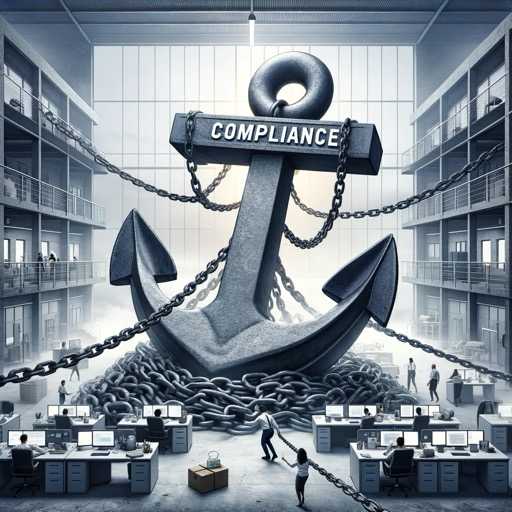
Figure: Bad example - Overemphasis on compliance can make an organization rigid and slow to respond to market changes Conclusion
Navigating the tightrope between ensuring compliance and governance, and preserving agility, is undoubtedly a challenging endeavor, yet it is essential for the modern organization.
A balanced approach in this regard is not just a best practice, but a strategic necessity. It enables organizations to confidently meet regulatory requirements while retaining the indispensable flexibility to adapt, evolve, and innovate in a fast-paced business environment.
This balance is key to building an organization that is not only compliant and responsible but also dynamic and forward-looking. In essence, by achieving this equilibrium, organizations set themselves up for sustainable success, adeptly positioned to meet the demands of both today and tomorrow.



